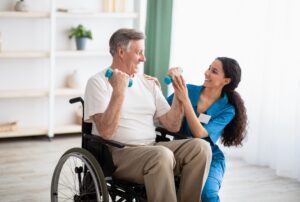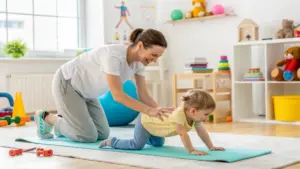
When a stroke, traumatic brain injury (TBI), or spinal cord injury (SCI) disrupts your life, the road to recovery can feel overwhelming. Yet every day, adults living with these conditions make remarkable progress through specialized neurologic therapy. This comprehensive guide explores how targeted rehabilitation can help restore function, rebuild independence, and renew hope.
Understanding Neurologic Injuries in Adults
Stroke
A stroke occurs when blood flow to the brain is interrupted, either by a blockage (ischemic stroke) or bleeding (hemorrhagic stroke). The resulting damage can affect movement, speech, cognition, and daily functioning. With approximately 795,000 strokes occurring annually in the United States, it remains a leading cause of long-term disability among adults.
Traumatic Brain Injury (TBI)
TBI results from an external force impacting the head, causing temporary or permanent damage to brain function. Falls, motor vehicle accidents, and sports injuries are common causes in adults. The effects can range from mild concussions to severe injuries affecting consciousness, memory, personality, and physical abilities.
Spinal Cord Injury (SCI)
SCI damages the spinal cord’s ability to transmit signals between the brain and body. Depending on the injury level and completeness, individuals may experience varying degrees of paralysis, sensory loss, and autonomic dysfunction. These injuries profoundly impact mobility, independence, and quality of life.
The Foundation: Neuroplasticity
The cornerstone of neurologic therapy is neuroplasticity—the brain’s remarkable ability to reorganize itself by forming new neural connections throughout life. Even after significant injury, the nervous system can adapt, compensate, and sometimes recover lost functions. Neurologic therapy leverages this capacity through:
- Repetitive, task-specific practice that reinforces new neural pathways
- Intensive training that challenges the nervous system to adapt
- Progressive difficulty that continues to stimulate growth
- Early intervention when neuroplasticity is typically most active
Core Components of Neurologic Therapy
Physical Therapy
Physical therapy focuses on restoring movement, strength, balance, and mobility. For adults recovering from neurologic injuries, physical therapists design individualized programs that may include:
Gait Training: Relearning to walk using techniques like body-weight supported treadmill training, parallel bars, and assistive devices. Therapists work on improving step length, speed, symmetry, and endurance.
Strength and Conditioning: Targeted exercises rebuild muscle strength weakened by disuse or nerve damage. Progressive resistance training helps restore functional abilities needed for daily activities.
Balance and Coordination: Specialized exercises and equipment challenge the vestibular system and proprioception, reducing fall risk and improving confidence in movement.
Transfer Training: Learning safe techniques for moving between surfaces—such as transitioning from a bed to a wheelchair, a wheelchair to a car, or a chair to a standing position—is essential for maintaining independence.
Occupational Therapy
Occupational therapists help individuals regain the skills needed for meaningful daily activities. Their interventions often include:
Activities of Daily Living (ADL) Training: Relearning essential self-care tasks like dressing, bathing, grooming, and eating. Therapists may introduce adaptive equipment or modified techniques to maximize independence.
Fine Motor Skills: Exercises targeting hand and finger coordination for tasks like writing, buttoning, or using utensils. This may involve therapeutic putty, pegboards, or functional activities.
Cognitive Rehabilitation: Addressing memory, attention, problem-solving, and executive function challenges through structured exercises and compensatory strategies.
Home and Work Modifications: Assessing environments and recommending adaptations—grab bars, ramps, specialized tools—that enable safer, more independent functioning.
Speech-Language Therapy
Speech-language pathologists address communication and swallowing difficulties common after neurologic injury:
Aphasia Therapy: For stroke survivors with language impairments, therapy focuses on improving comprehension, word-finding, speaking, reading, and writing through evidence-based approaches.
Dysarthria Treatment: Exercises strengthen the muscles used in speech and improve breath support, articulation, and vocal quality when weakness or incoordination affects speaking.
Cognitive-Communication Therapy: Addressing attention, memory, reasoning, and social communication skills affected by TBI or stroke.
Dysphagia Management: Evaluating and treating swallowing disorders through exercises, compensatory strategies, and diet modifications to ensure safe nutrition and hydration.
The Therapeutic Timeline
Acute Phase (Days to Weeks Post-Injury)
Early intervention begins in the hospital, focusing on preventing complications such as pneumonia, blood clots, and pressure ulcers. Therapists work on basic mobility, positioning, and early functional activities as medical stability allows.
Subacute/Rehabilitation Phase (Weeks to Months)
This intensive period typically involves inpatient or outpatient rehabilitation with multiple therapy sessions daily. Rapid gains often occur as neuroplasticity is most active. Goals focus on maximizing functional recovery and building independence.
Chronic/Long-Term Phase (Months to Years)
Recovery continues well beyond the initial months, though at a slower pace. Ongoing therapy maintains gains, prevents secondary complications, and works toward long-term functional goals. Many survivors continue therapy for years, achieving meaningful improvements.
Maximizing Your Recovery Journey
Set Meaningful Goals: Work with your therapy team to establish specific, personalized goals that reflect what matters most to you—whether that’s returning to work, living independently, or enjoying hobbies.
Stay Committed: Recovery requires persistence. Even when progress feels slow, consistent effort and practice drive neuroplastic changes that accumulate over time.
Practice Beyond Therapy: The most successful recoveries involve extensive practice outside formal therapy sessions. Your therapists will provide home exercise programs designed to reinforce skills.
Advocate for Yourself: Learn about your condition, ask questions, and communicate openly with your healthcare team about your needs, concerns, and goals.
Connect with Others: Support groups and peer mentorship provide emotional support, practical advice, and inspiration from others who understand your journey.
Maintain Hope: Recovery timelines vary widely, and improvements can occur years after injury. Numerous individuals continue achieving meaningful functional gains through sustained effort and appropriate therapy.
Looking Forward
Neurologic rehabilitation continues to evolve with emerging technologies, refined techniques, and a deeper understanding of neural recovery. Brain-computer interfaces, advanced neuroprosthetics, stem cell research, and novel pharmacological interventions offer promising possibilities for future treatment.
For adults living with stroke, TBI, or SCI, Welldom offers neurologic therapy that provides more than physical treatment—it offers a structured path toward reclaiming independence, rebuilding identity, and rediscovering purpose in the comfort of home. While the journey demands patience and perseverance, countless individuals demonstrate daily that remarkable recovery is possible.
Your nervous system possesses extraordinary resilience. With specialized therapy, dedicated effort, and comprehensive support, you can harness that resilience to write the next chapter of your recovery story.



